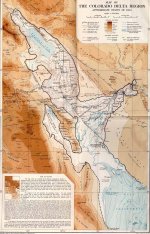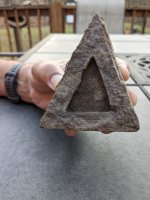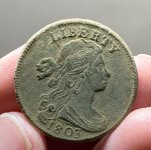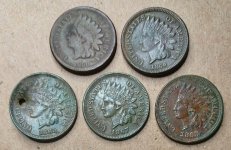pegleglooker
Bronze Member
- Jun 9, 2006
- 1,857
- 237
- Detector(s) used
- ace 250
- Primary Interest:
- All Treasure Hunting
Thought you guys might like this.... Your thoughts??
The hardest thing to do when researching old legends, is the long tedious time spent in libraries and historic societies looking for clues. The internet is my friend... But while pouring over huge volumes sometimes you find just a tidbit of info, or while talking to like minded people someone says “hey did you hear about this?” and then BAM it all comes together. This just happened a few days ago...
Over the years, I have been intrigued by the Laguna Salada area of Mexico. Located just south of the border, in the Sonoran desert of Baja California and within minutes of Mexicali. This lake is not as deep as the Salton Sea, it's only 30 feet below sea level and hardly ever full. But at 37 miles long and 11 miles wide, it’s nearly the same size as the current Salton Sea. However, this lake does have a clear advantage, it may have at one time or another directly connected to the Colorado River near the headwaters of the Sea of Cortez. This would make it about seventy five miles closer to the Sea of Cortez than the Salton Sea. Could the legend really be about a ship in Mexico and not the US? It's a good possibility.
Ok, so whose ship was it and how did it end up just south of the border? In a previous article I did explain how the English pirate/privateer Thomas Cavendish and his fleet of three ships captured the seventy ton Spanish galleon Santa Ana in 1587. This happened near the the tip of Baja California close to present day Cabo San Lucas. Cavendish and crew attacked and subdued the ship, then towed it into the port. When they boarded the Santa Ana they were surprised that a ship of this size did not have any cannons on-board, and the booty was the largest they have ever seen. It took them nearly two weeks to commandeer the best of her cargo, there was simply way more than cargo then they could carry on all three of their ships. They burned what was left of the ship and the desirable cargo, leaving the Spanish captain and crew on land, then sailed for the Philippines. However, shortly after setting sail, one of his ships, the sixty ton galleon Content, was never seen again. To date there is no known report of either a sighting or capture of a English ship of this size, so where did they go? The prevailing belief at this time, was that California was an island and that the Straits of Anian lay just north of Cabo San Lucas. So with this in mind, they likely headed due north. After all, you just stole a sixty ton galleon full of silks, damasks, spices, cotton, ivory, jade and cigars, I'm sure Cavendish stored all the gold and silver aboard his ship. But meanwhile you have just become rich beyond your imagination and needed to get to a safe place, and fast. Otherwise if you're caught, you surely would be swinging from the yardarm.
 N
N
Now comes the "leap of faith," because no one knew for sure if there was a quicker way back to Europe via a northern route. In fact the Spaniards called the northern end of the Sea of Cortez, "The Northern Mystery," because they weren't exactly sure what was there and if any of it was navigable. The maps of the day are the best resource one could find and there is nothing said about Cavendish finding a map on the Santa Ana. Then again, it also doesn't state if he didn't find one either. Which brings to mind the curious 1570 atlas/map of from Portuguese nautical cartographer Fernao Vaz Dourado, which shows two waterways at the head of the Sea of Cortez. The one that is heading northeast would have clearly been the Colorado River, but what about the one headed northwest? Could this map be showing that at one time European explorers were aware of water in the Laguna Salada and does this also mean that the English were just as aware, or found out when they sacked the Santa Ana? Either way, if the mutineers were able to take a look at this map, then they may have thought they have a way to escape.
So far we have a suspect in the crew of the Content, along with the Dourado map and now we have the diary of Father Ascension, who accompanied Sebastian Vizcaino on his 1602 expedition of the California coast. This would have been only fifteen years after the Content and crew escaped. While Vizcaino and Asenscion were anchored in what is now San Diego Bay, they were greeted by a local Indians who told them of other people living inland, people like the Spaniards, who "sported beards and wore collars and breeches, and other fine garments like ours." As Father Ascension wrote in his diary, he also surmised that these people were most likely Dutch or English and that they had settled on the western coast of the Laguna Salada. The Indians even extended an offer to take Father Ascension to where they were living, a distance of less than 100 miles. You have to think about this for a second, if you stole a ship loaded with the wealth of Manila, you were a very rich man, a very rich man indeed. The amount of trading you would be able to do with all the local Indians could be mind boggling. I am sure that word among the Native Peoples probably spread pretty quickly.
 Ship Petroglyph courtesy of Robert Marcos
Ship Petroglyph courtesy of Robert Marcos
This all sounds great and is a wonderful idea, but is there any proof that a ship actually sailed into the Laguna? Possibly, near the northwestern end of Laguna Salada is a place called Pinto Canyon where a well known petroglyph was found. Most people consider this petroglyph to be a rendering of what appears to be a European style ship, perhaps a galleon. Today this area is a hotbed for drug and immigration smuggling, so it's best not to go without being with a couple of the BLM boys. If you do want to get a close look without the hassle, this is a copy of the rock in front of the Maritime Museum of San Diego. Let's quickly recap, we have a ship, a map, a rock, and a diary, but then we have the incredible story of W. Morlin Childers, a local rancher in El Centro California who became a noted archaeologist. He was an amateur archaeologist working with college students from the Imperial Valley. His collection of early man artifacts, some over 20,0000 years old, now resides at the Imperial Valley Museum in Ocotillo California. He was credited with finding a 40,000 year old skeleton of what was dubbed the Yuha Man. Further testing however, clarified the date to about 20,000 years ago, still a great find no matter what. Somewhere along his travels, which included the Yuha desert, again just northwest of the Laguna Salada area, he came upon a ship, in the middle of the desert. There was a old mast and collar sticking out of the desert floor, so Morlin probed the ground to see if anything was below. Morlin stated that the collar appeared to be very old and worked by hand, it was not made by a machine.
 While investigating the site of a buried ship in the Mexicali Valley, Jim Atkins and Jim Bailey probe the surface with a metal bar while Morlin Childers looks on. An object was struck, attesting that the remainder of the ship lay below.
While investigating the site of a buried ship in the Mexicali Valley, Jim Atkins and Jim Bailey probe the surface with a metal bar while Morlin Childers looks on. An object was struck, attesting that the remainder of the ship lay below.
Bill Fitch, the former editor of the Imperial Valley Press thought it was a big enough story to dedicate a full page article about it in 1968. According to the article, Morlin found this ship in a "Mexicali Valley" and returned to El Centro with the collar, Fitch also states that the ship arrived there most likely due to a tidal bore. To me the collar is a extremely important piece, but where it is today is completely unknown. I would venture to guess though, that someone, somewhere in the Imperial Valley, may have seen it a t one time, or even might know where it is today. If you or anyone you know is aware of this collar, please send me a private message, I would love the opportunity to see/find this collar and examine it. Not sure how we could date the metal that was used to make the collar, but how great would it be if it was found to be from a sixteenth century English ship!!! This could be the ONLY documented find from a ship that could be considered the Lost Ship of the Desert...
This article is courtesy of Lost Ships of the Desert
The hardest thing to do when researching old legends, is the long tedious time spent in libraries and historic societies looking for clues. The internet is my friend... But while pouring over huge volumes sometimes you find just a tidbit of info, or while talking to like minded people someone says “hey did you hear about this?” and then BAM it all comes together. This just happened a few days ago...
Over the years, I have been intrigued by the Laguna Salada area of Mexico. Located just south of the border, in the Sonoran desert of Baja California and within minutes of Mexicali. This lake is not as deep as the Salton Sea, it's only 30 feet below sea level and hardly ever full. But at 37 miles long and 11 miles wide, it’s nearly the same size as the current Salton Sea. However, this lake does have a clear advantage, it may have at one time or another directly connected to the Colorado River near the headwaters of the Sea of Cortez. This would make it about seventy five miles closer to the Sea of Cortez than the Salton Sea. Could the legend really be about a ship in Mexico and not the US? It's a good possibility.
Ok, so whose ship was it and how did it end up just south of the border? In a previous article I did explain how the English pirate/privateer Thomas Cavendish and his fleet of three ships captured the seventy ton Spanish galleon Santa Ana in 1587. This happened near the the tip of Baja California close to present day Cabo San Lucas. Cavendish and crew attacked and subdued the ship, then towed it into the port. When they boarded the Santa Ana they were surprised that a ship of this size did not have any cannons on-board, and the booty was the largest they have ever seen. It took them nearly two weeks to commandeer the best of her cargo, there was simply way more than cargo then they could carry on all three of their ships. They burned what was left of the ship and the desirable cargo, leaving the Spanish captain and crew on land, then sailed for the Philippines. However, shortly after setting sail, one of his ships, the sixty ton galleon Content, was never seen again. To date there is no known report of either a sighting or capture of a English ship of this size, so where did they go? The prevailing belief at this time, was that California was an island and that the Straits of Anian lay just north of Cabo San Lucas. So with this in mind, they likely headed due north. After all, you just stole a sixty ton galleon full of silks, damasks, spices, cotton, ivory, jade and cigars, I'm sure Cavendish stored all the gold and silver aboard his ship. But meanwhile you have just become rich beyond your imagination and needed to get to a safe place, and fast. Otherwise if you're caught, you surely would be swinging from the yardarm.
 N
NNow comes the "leap of faith," because no one knew for sure if there was a quicker way back to Europe via a northern route. In fact the Spaniards called the northern end of the Sea of Cortez, "The Northern Mystery," because they weren't exactly sure what was there and if any of it was navigable. The maps of the day are the best resource one could find and there is nothing said about Cavendish finding a map on the Santa Ana. Then again, it also doesn't state if he didn't find one either. Which brings to mind the curious 1570 atlas/map of from Portuguese nautical cartographer Fernao Vaz Dourado, which shows two waterways at the head of the Sea of Cortez. The one that is heading northeast would have clearly been the Colorado River, but what about the one headed northwest? Could this map be showing that at one time European explorers were aware of water in the Laguna Salada and does this also mean that the English were just as aware, or found out when they sacked the Santa Ana? Either way, if the mutineers were able to take a look at this map, then they may have thought they have a way to escape.
So far we have a suspect in the crew of the Content, along with the Dourado map and now we have the diary of Father Ascension, who accompanied Sebastian Vizcaino on his 1602 expedition of the California coast. This would have been only fifteen years after the Content and crew escaped. While Vizcaino and Asenscion were anchored in what is now San Diego Bay, they were greeted by a local Indians who told them of other people living inland, people like the Spaniards, who "sported beards and wore collars and breeches, and other fine garments like ours." As Father Ascension wrote in his diary, he also surmised that these people were most likely Dutch or English and that they had settled on the western coast of the Laguna Salada. The Indians even extended an offer to take Father Ascension to where they were living, a distance of less than 100 miles. You have to think about this for a second, if you stole a ship loaded with the wealth of Manila, you were a very rich man, a very rich man indeed. The amount of trading you would be able to do with all the local Indians could be mind boggling. I am sure that word among the Native Peoples probably spread pretty quickly.
 Ship Petroglyph courtesy of Robert Marcos
Ship Petroglyph courtesy of Robert MarcosThis all sounds great and is a wonderful idea, but is there any proof that a ship actually sailed into the Laguna? Possibly, near the northwestern end of Laguna Salada is a place called Pinto Canyon where a well known petroglyph was found. Most people consider this petroglyph to be a rendering of what appears to be a European style ship, perhaps a galleon. Today this area is a hotbed for drug and immigration smuggling, so it's best not to go without being with a couple of the BLM boys. If you do want to get a close look without the hassle, this is a copy of the rock in front of the Maritime Museum of San Diego. Let's quickly recap, we have a ship, a map, a rock, and a diary, but then we have the incredible story of W. Morlin Childers, a local rancher in El Centro California who became a noted archaeologist. He was an amateur archaeologist working with college students from the Imperial Valley. His collection of early man artifacts, some over 20,0000 years old, now resides at the Imperial Valley Museum in Ocotillo California. He was credited with finding a 40,000 year old skeleton of what was dubbed the Yuha Man. Further testing however, clarified the date to about 20,000 years ago, still a great find no matter what. Somewhere along his travels, which included the Yuha desert, again just northwest of the Laguna Salada area, he came upon a ship, in the middle of the desert. There was a old mast and collar sticking out of the desert floor, so Morlin probed the ground to see if anything was below. Morlin stated that the collar appeared to be very old and worked by hand, it was not made by a machine.
 While investigating the site of a buried ship in the Mexicali Valley, Jim Atkins and Jim Bailey probe the surface with a metal bar while Morlin Childers looks on. An object was struck, attesting that the remainder of the ship lay below.
While investigating the site of a buried ship in the Mexicali Valley, Jim Atkins and Jim Bailey probe the surface with a metal bar while Morlin Childers looks on. An object was struck, attesting that the remainder of the ship lay below.Bill Fitch, the former editor of the Imperial Valley Press thought it was a big enough story to dedicate a full page article about it in 1968. According to the article, Morlin found this ship in a "Mexicali Valley" and returned to El Centro with the collar, Fitch also states that the ship arrived there most likely due to a tidal bore. To me the collar is a extremely important piece, but where it is today is completely unknown. I would venture to guess though, that someone, somewhere in the Imperial Valley, may have seen it a t one time, or even might know where it is today. If you or anyone you know is aware of this collar, please send me a private message, I would love the opportunity to see/find this collar and examine it. Not sure how we could date the metal that was used to make the collar, but how great would it be if it was found to be from a sixteenth century English ship!!! This could be the ONLY documented find from a ship that could be considered the Lost Ship of the Desert...
This article is courtesy of Lost Ships of the Desert
Amazon Forum Fav 👍
Attachments
Last edited:









